On the other hand, the brand is an intangible and abstract idea; the marketer’s job is to turn that into a tangible one through brand storytelling. The idea is immaterial and needs an explanation to turn it into information. You can’t experience an idea, but you can experience ice cream with tastes, smells, and colors. The concept of ice cream comes to your mind after believing that the thing feels like ice cream.
So, it’s a belief system that depends on proper communication and on delivering information in the correct order. Correct order indicates a structure (of information) that can align the receivers’ state of mind and make them get the idea. When a marketer brands a corporation, she demonstrates an idea relatable to the business and the customers’ real-life experiences or fantasies, leading them to believe what he (the marketer) says. The story of a naked king is worth mentioning here.
The king was blindfolded into believing he had bought a beautiful outfit from two swindlers. There was a condition that two marketers threw to the king – if he (the king) couldn’t see the beauty of the cloth, he would be the most stupid king ever. The king didn’t want to represent him like that. So, he put on the outfit and bullied the populace into believing that only intelligent people would appreciate his dress. No one wanted to be that out-of-dated either, not to honor their king’s new outfit except a child, not blindfolded, who revealed that the king was naked.
Though, people got angry with that child as they already believed the conventional and established story of the two swindlers. Actually, people tend to lie to themselves to feel something they have already decided to think irrationally. The two tricksters just aired the sail.
What is Brand Storytelling?
Brand storytelling captures the emotional attachments of a large audience by telling stories that match the context of the brand and the audience’s worldview. Many think that stories and narratives are similar, but they are not. If you feel bored while listening to someone, it indicates that the person is not telling you a story; instead, he is torturing you with narratives. The story is not a journey either, nor the process or chronology. The story escalates the conflict-driven events that cause the change in the character’s life.
If you are thinking about a story for your brand, it’s better to focus on building a character or protagonist who will face a targeted problem your potential customers are facing in their real life. The human mind prioritizes those with shared interests (similar situations) and avoids others. The priority will turn into empathy in the later stage, leading your audiences to imagine themselves in the protagonist’s place and feel the urge of the protagonist to find that solution. The more relevant your story will be to your targeted problem, the more potential (and appropriate) customers (targeted audiences) will feel the urgency and value of the solution (products or services) you (want to) provide.
Brand storytelling aims to evaluate customers’ feelings when experiencing products or services of that brand. Many brands nowadays are unaware of the promises they make in their advertising story, damaging their reputation. People will feel cheated when they find inconsistencies in the story. They will hate it if the brand takes the initiative to change their (the audience’s) minds. Everybody hates it when they are proven wrong. Brand storytelling aims to bridge the customers’ feelings and emotions with the brand. The stronger this bridge is, the more meaningful the brand (the abstract idea) will be.
Types of Storytelling
The primary storytellers used to arrange meetings surrounded by fire, and the duration of their tales relied on how long the listeners felt comfortable sitting in one place, concentrating on one concept at a time. It resulted in the traditional two-hour playtime. Then industrialization took place, and a new perspective of implementing stories was discovered. Industrialization (and globalization in the later stage) resulted in the massive production of brand stories (advertising). The duration of stories evolved to below three minutes (on youtube) and thirty seconds (in TV advertising) from that two-hour traditional playtime.
In his book Storynomics, Robert Mckee showed two types of storytelling.
- Fiction-told Story
- Purpose-told Story/Brand Storytelling
Both types make us laugh at something we never thought funny or cry at something we didn’t find tragic. We gain insight or wisdom from both fiction and brand stories. The new understanding leads us to feel new types of emotion. The difference is that fiction-told stories can demonstrate any concept within any timeframe, while brand storytelling abbreviates the idea and delivers it briefly. In other words, fiction aims to show any detail depending on how the author wants it to be alike. In contrast, brand storytelling seeks to deliver the concept in the shortest form without the bombardment of information.
Fiction vs. Brand Storytelling
The differences can clarify and specify each type.
| Differentiator | Fiction-told Story | Brand Storytelling |
| Duration | Fiction has no limited duration to maintain. | Brand Storytelling should be short as the audience will give slight attention. |
| The extent of Knowledge | Fiction can demonstrate any concept in detail, also as many concepts as it needs. | Purpose-told storyteller excludes repetitive information and is choosy while picking which information to evaluate. |
| Experiencing | A Fiction-told story can be experienced at once. | Brand Story reminds us about the concept of the story every time we purchase from that brand and utilize its offerings. |
| Depending | The author is the freedom decision maker of any issue with the fiction-told story. People praise the author, hoping he will deliver the same kind of pleasure again (and again). | The audience of the purpose-told story ignores its creator as the story represents the brand image instead of the author. |
| Climax | The fiction-told story aims to finish its audience’s specific experience at the climax of that story. | The brand storytelling leads its audience to the reality at the climax, and it’s the purchase decision and utilization. The ending of the purpose-told story varies from person to person. |
That is, brand storytelling can break the boundary of storytelling, undoubtedly. The audience of the purpose-told story (or the brand-storytelling) becomes the participant of the story after substituting their real-life expectations with the protagonist’s urge. It becomes a pleasure to the audience when they find a solution (at least) the brand has, and it’s just a purchase away.
The brand storytelling doesn’t have a climax in the storytelling. Instead, the ending belongs to the audience’s real-life experience after purchasing and utilizing it.
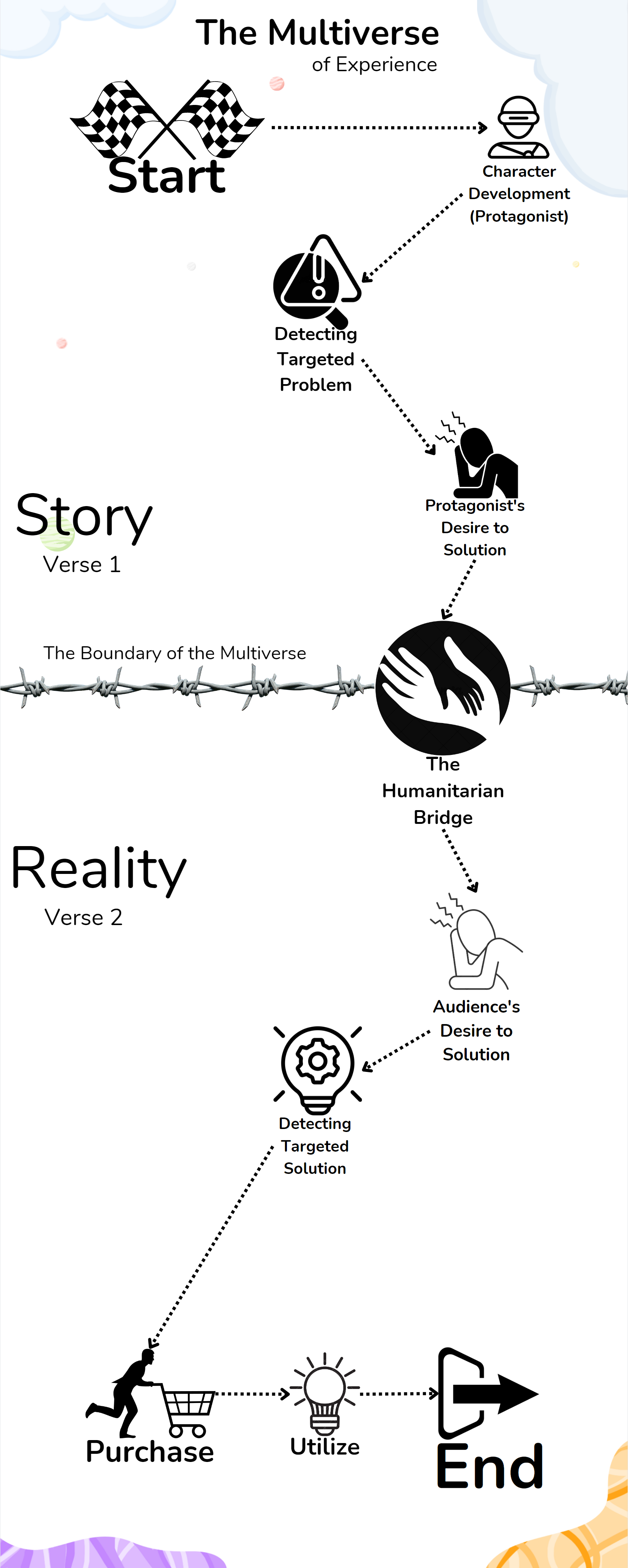
The Mirror Experience
A well-told story aims to create a multiverse of experiences where the verses mirror each other. The preceding verse represents the protagonist of the story, who is searching for a solution to a targeted problem. The second is the metaphor of the audience’s minds, where the reflection occurs. That is, when the audience of the story relates his wants or needs with the protagonist’s urge, here the mirror experience takes place.
The mirror experience has two types – one is mental, and the other is emotional.
When the audience faces a set of agitation and questions similar to the protagonist, the mental mirror experience happens. Curiosity raises questions like – “What will happen next?” “What is the solution?” “Will the protagonist win?” resulting in the primary mirror experience.
After connecting with curiosity, Empathy makes the audience substitute themselves emotionally with the protagonist. Thus, they enter the story imaginarily, taking part in it and ending it on their own in real life (by purchasing and utilizing the solution, product, or service). The story is a set of scenarios (or situations) maintaining continuity, and empathy is the connector between the concerns of the protagonist and the audience. That is, empathy is the thing that breaks the boundary between imagination and reality.
The function of Empathy works in two steps in a fiction-told story, while brand storytelling adds an addition.
Identification
After being driven by curiosity, audiences keep watching or reading the story, which leads them to feel the shared humanity between them and the protagonist. In this stage, the audience’s instinct arouses logic like – The character in the story is a human being facing a situation – I completely understand as I encounter it very often. Therefore, I want him (or her) to overcome the case as I would like it for myself (if I were in his place). In other words, the audiences build a humanitarian bridge in this stage that emotionally connects them with the story.
The Subconscious Switch
The subconscious switch is a substitutor. After identifying, the audiences start owning the story as if it is their own, substituting the storified desire (of the protagonist) with their real-life desire. So, desire is the thing (the most powerful thing, of course) that arouses empathy, enabling the story to break the boundary between the story and reality, resulting in the protagonist rooting the object of desire in the story and the audience in their real life. This way, desire helps the audiences to experience the tale subconsciously as if it is their own.
Real-life Action
Once the audiences imaginarily substitute themselves with the protagonist, they permit the story to manipulate and motivate them to take action in real life. The fiction-told tale doesn’t necessarily need this stage. Still, it is essential for brand storytelling—the brand storyteller inputs a targeted problem in a brand story, whose solution is aimed to sell. When the audiences notice that the protagonist finds that solution, which is just one purchase away, they become encouraged to purchase (take action), utilize the product, and end the story in reality by taking away from the protagonist.
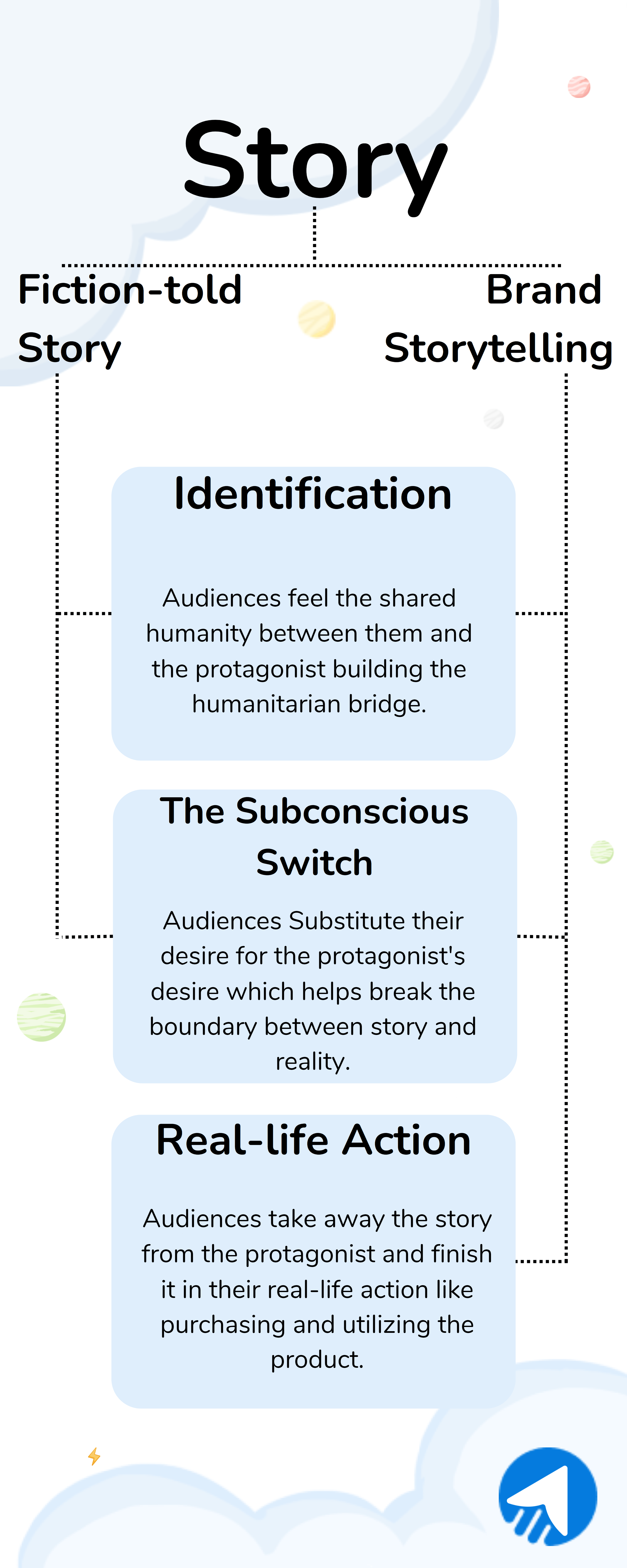
The First Impression
As mentioned earlier; people can’t function anything without its story, not even the idea of the story itself. The object of the story is a set of conflict-driven events that can’t be the story by themselves. Rather, a subject (someone) needs to perceive the continuity of those events over time. In other words, the idea (of the continuity of conflict-driven events) needs a host, a human brain, to be storified. The description of that perception (or experiences) of the conflict-driven events (gradually) can build up the story. Perceiving the first event is the first impression that occurs only when a change occurs.
We only notice an event after detecting differences compared to the previous ones and ignore the unchanged events.
The characteristics of frogs are worth mentioning here. A frog can target a fly flying around, aiming its tongue, launching it, and then capturing it in less than a second to fulfill its need (for nutrition). However, if the flies don’t fly, the frog won’t be able to detect them. No matter how many flies (nutrition) surround it, only change (flying or moving object) can help them notice. Otherwise, they will wait till death, starving.
We are just like frogs. We notice only changes at the first impression.
The Psychology Behind the First Impression
So, that’s it. The first impression occurs when change takes place, and the subject (the host or the human brain) experiences the change. What makes it valuable is that it’s impossible to get a second chance to make the first impression. Instead, according to Forbes, you will get up to 7 seconds to build the first impression into someone’s mind. But the snap judgment, which helps with trustworthiness before connectivity, takes only a fraction of a second (100 milliseconds or one-tenth of a second). Actually, our past experiences help us to imagine, and relying on that, we make a guess and wish it to be true.
Here are the several steps in which our brain deduces the first impression.
Perceiving the Change
Change is the only concern. That is, there will be no attention if no change takes place. We check watches now and then to track the change (of time). We can detect if there is any change within a moment while walking into our house. Similarly, when the flow of a story changes, it grabs our (audience’s) attention. We only notice something after finding the difference while comparing it with the status quo (the existing order of things).
Looking for a Reason
The human mind needs causation to accept the changed data. In other words, people need to know why things change from the status quo. Whenever there is any concern, our mind attempts to describe it, synchronizing it with previous experiences and imaginations.
Predicting Based on Reasoning
The human mind tends to remain in the status quo, which helps us avoid the first impression. On the contrary, we need to communicate with others that starts from the first impression. The most interesting part is that we predict based on our experiences and imagination (causation). We want our images of minds to come true so that our brains can settle back to ignoring the facts. Thus, the first impression continues only when our prediction goes wrong. In other words, we keep noticing something only when it goes against us.
Avoiding Contrary Data
Noticing creates new assumptions based on the change. The updated assumptions or experiences lead us to a changed state of mind and tend to remain in the (new) status quo, ignoring all the upcoming conflicted data. An example is necessary here for clarification. Though everybody knows that the UN shows partiality to the US and its allies without considering third-world countries, the dominant governments avoid it as it contradicts them. Instead, they present the information and logic that support them to maintain their status quo (continue to enjoy the advantages).
The Decision
Though the story is the strongest thing, we are the ones that decide how the story will flow. A story doesn’t have any chance to move forward without its host (the human mind). The host sits in the driving seat of the story to decide what he wants. After noticing (first impression), we pick something to turn into a story (to remember, as we hardly remember something without the story).
We know that our worldview influences our choice and taste. As our brains ensure, we get what we want (in stories). In other words, we design the strongest thing – the story.
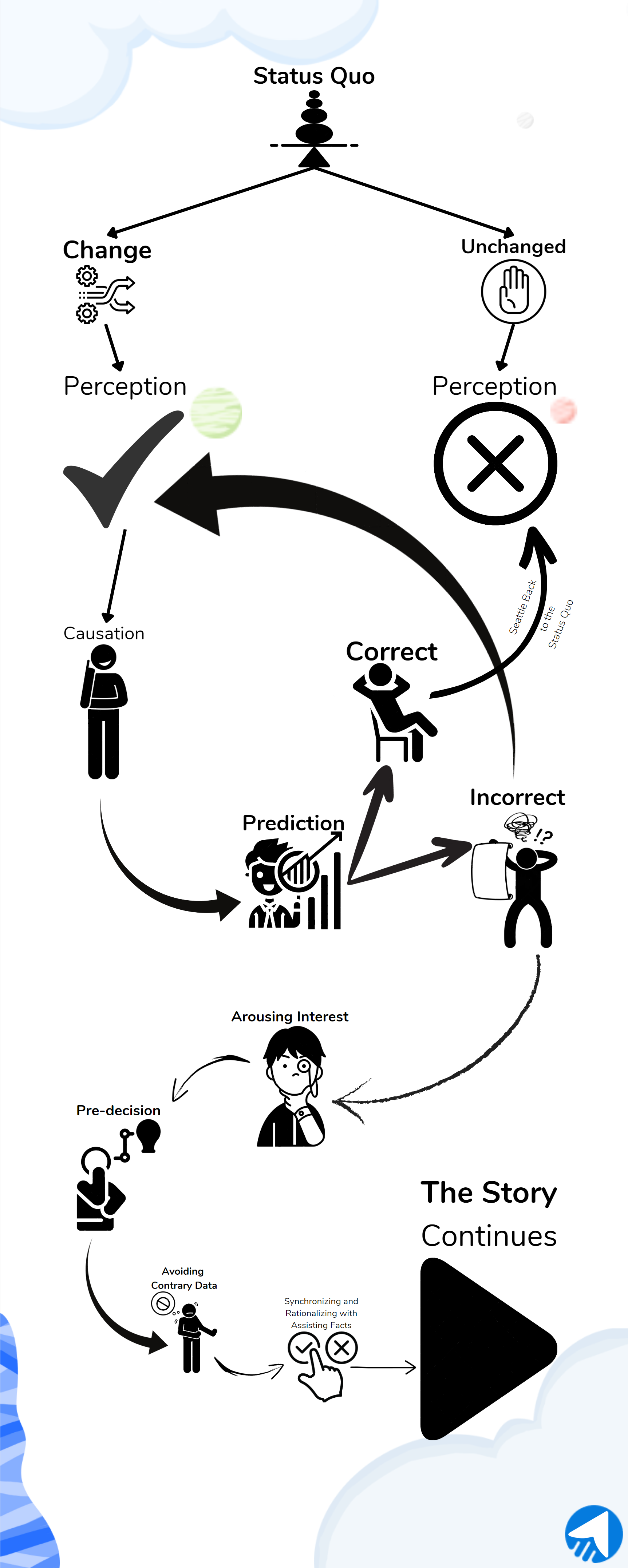
At the end of all terms, the first impression is the thing that influences the brand storytelling, making our minds.
Rationalism Defends the First Impression
The story starts with the first impression: the most powerful thing that propels all judgments and decisions. Although decision-making is a rational process, the first impression that manipulates the process is itself irrational. As mentioned earlier, the human brain took a lot of time to be evaluated, and the first discovery of the human brain is the human mind, a self-conscious and self-separated thing. Self-consciousness took us to the “ego” and the belief, which resulted in separation.
On the other hand, our experiences made us rely on cause and effect, resulting in practicing rationalism. The question is, what do we do with rationalism?
Rationalism aims to protect our ego, the tendency to be different from others. Again, change, or difference is the key to the first impression. Thus, rationalism is the way to protect the snap judgment and overall first impression. Notice that I tried to answer the most asked question with deductive logic:
Rationalism aims to defend our tendency to be different or change.
Change or difference is the key to the first impression.
Thus, rationalism seeks to protect the first impression.
Deductive logic represents causation, without which it wouldn’t be possible to explain how rationalism functions, which is the most exciting thing.
Imagine that you have a restaurant beside a highway, competing with two more, standing side by side. Suppose you have a better car parking and walking yard that your competitors don’t. In that case, you might be able to influence your customers (those who drive cars) at the first impression as the consumers will find comfort within a fraction of a second and will make up their minds to enter yours instead of your competitors. Their ego will enable them to avoid all the unfavorable data that can defocus them from their snap judgment.
Worldview
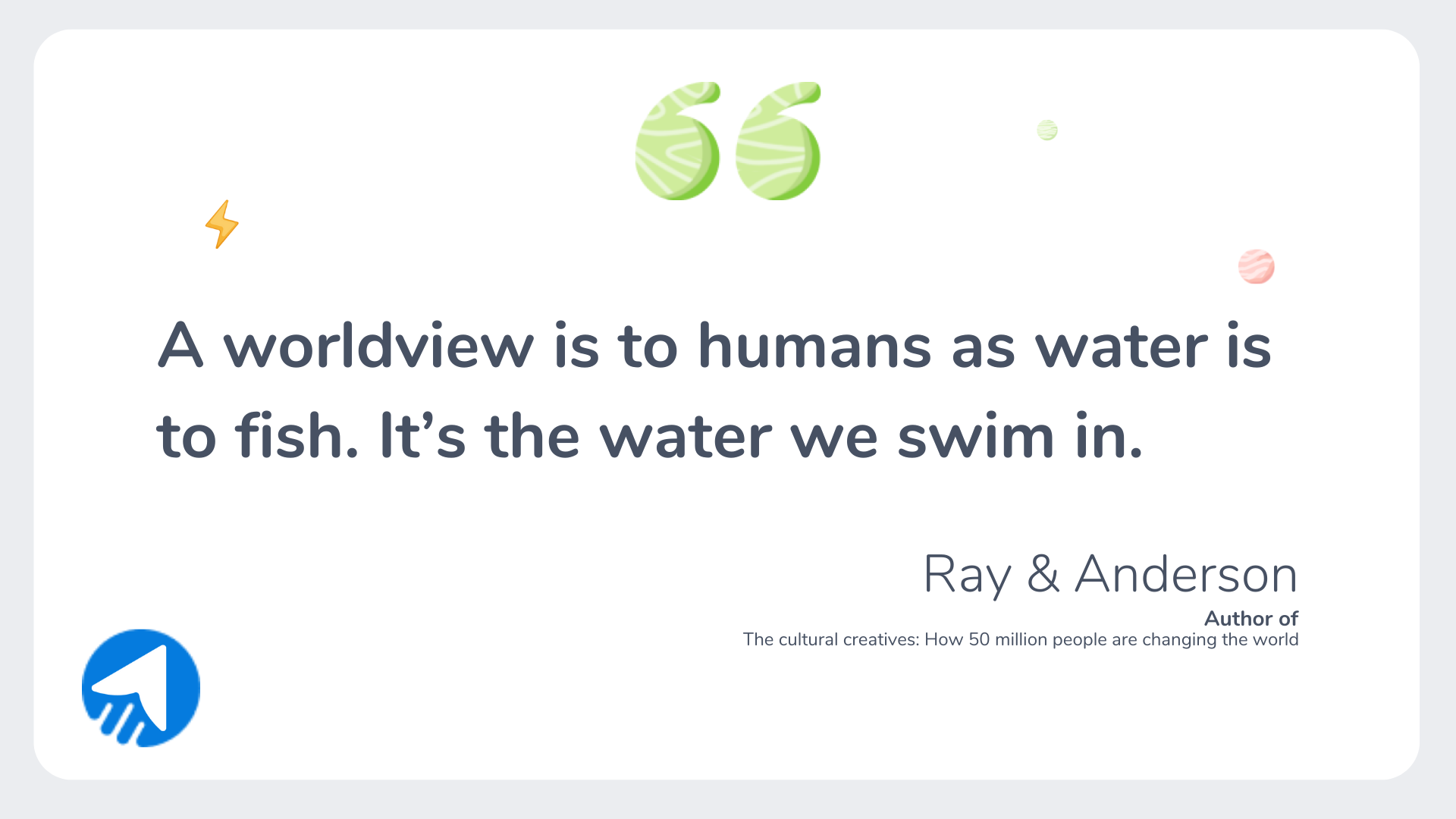
We keep ourselves active (and existential) and engaging with our worldviews- the content of anything we believe is actual. When we were born, we were nothing but a blank page. Later on, we started gaining experiences from our parents and surroundings, with which we stained that page, turning nothingness into something meaningful. The “meaning” means that a concept or idea derived from an experience is intended to express something which is understandable to (some) others. And the understanding comes from relating the input information with the worldviews. We focus on those we tend to synchronize with our worldviews instead of concentrating on the worldview itself, just like we breathe oxygen and don’t usually focus on breathing.
Worldview is the foundation of understanding. It is not a series of beliefs but a more profound concept that sews seeds and enables us to make decisions. Though the storyteller (or marketer) starts the purpose-told story, it relies on the audience’s decision, as demonstrated before. Worldview influences the audience, and the audiences do the rest to drive the story.
The Importance of Understanding Worldview
Worldview exists whether we understand this concept. Although it’s possible to understand something without being able to understand what the understanding is, it’s impossible without having a worldview. (Understanding indicates connecting others’ sympathetic awareness, feelings, and thinking patterns.) Thus, there are reasons why you should understand the worldviews of your audience.
Firstly, no other thing (like belief, ethos, or ideologies) can capture the form of the essence of human beings as worldview does. In a word, people need the worldview to be understood to know the form of humanity.
Secondly, you won’t be able to capture a location’s culture without knowing the local people’s worldview. Culture determines how the form of society will be, and the worldview rules the culture.
Thirdly, we are political and conscious beings, and politics rely on the worldview. Politicians talk about what the citizens want to hear and do what they want them to do, as it brings them the highest popularity. People tend to accept those who match their worldviews. The same goes for marketers. Thus, understanding worldviews will allow you to feel your potential audiences’ interests. The more relevant your message sync with the worldview of your audiences, the more effective it will be.
In a word, worldview is essential for the most effective communication.
Why is the Research on Worldview Limited?
Despite being the root of human existence, the term “worldview” is neither popular as a subject of discussion nor a scholarly research topic. People tend to assume based on something without focusing on the basis. If you start digging deeper to find the reason for something, it will probably lead you to nothingness. Understanding is impossible based on nothingness; instead, when you think about nothing, it becomes something we arouse by assuming something to be alike. If you start finding reasons for the existence of understanding, it might gradually lead you to the concept of creators, the abstract idea that needs assumption to turn into thinking.
Worldview is an abstract thing that empowers self-awareness. It can drive people to be aware of their rights, ability, limitations, and weaknesses, but it can’t be the central research topic. People can feel it, but they are not prepared enough to express it without misunderstanding.
Most importantly, people enjoy the feelings without understanding them. Thus, they are not aware of the existence of the worldview. This is the reason why we feel our existence.
Things Affecting Worldview
Worldview starts developing after birth when children are nothing but blank pages. A blank is supposed to be filled. Parents feel the responsibility to fulfill their children with an understanding of the worldviews in which they live in. In his book – Moral Politics: How Liberals and Conservatives Think, George Lakoff showed two types of worldviews, one is conservative, and the other is liberal. Both have different types of moralities derived from different types of families.
Conservative Worldview
Those with conservative worldviews have grown under the “strict father morality,” where the parents inject discipline forcefully. The “strict father model of the family” is authoritative, as the master of the family sets the overall family policy and constricts children to abide by what they composed. If the children show reluctance with it, the master arranges punishments, believing that children must not be cuddled. Because they believe cuddling will lead the children to be spoiled. They also believe that the spoiled child will be dependent and will not be educated by moral lessons.
Thus, when children become mature under strict supervision, they cherish the habit they gained from their parents, owning conservative worldviews. This type of worldview tends to remain unchanged, whereas a liberal worldview has at least a chance.
Liberal Worldview
People with liberal worldviews have well-nurturant parents while they are growing up. They belong to the Nurturant Parent Model of the Family, where the parents don’t believe in domination and interference. Instead, they provide support and protection, emphasizing their opinions. They care for and respect their child, and the children learn that so, which leads them to mutual understanding based on mutual respect. Liberal worldviews aim to lead children to be fulfilled with empathy to understand others and the capacity to take the community responsibilities by themselves instead of under pressure.
The nation as Family
According to Goerge Lakoff, the nation nurtures its citizens like parents do to their children, which makes the nation the influencer of the worldview. The policy and legislation of a state affect the worldviews of its citizens conservatively, while the cultural activities, philosophy, and literature assist the growth of the liberal worldview. Thus, we all have two types of worldviews altogether; one wants to be in the status quo, while the other wants changes. The human mind has that duality to maintain. The nation plays a vital role in nurturing such duality with its elements like cultures, laws, education, institutions, land, and everything that forms the nation and the state.
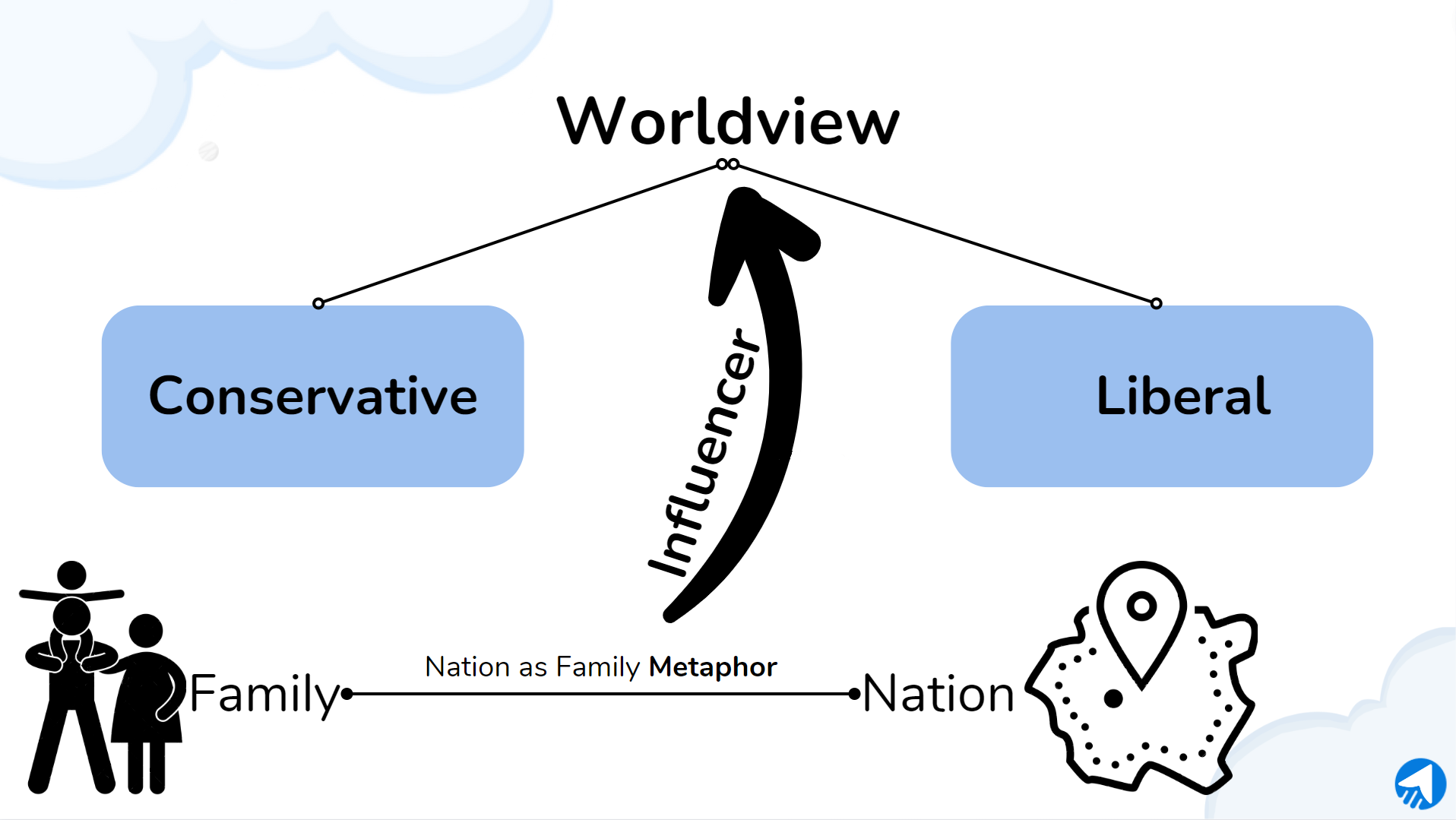
Though globalization helped the concept of culture (of a nation) to manipulate others, it reduced the influence of family and nation over worldviews. Later on, worldview became so complicated to understand by researching the culture and philosophy of a nation.
The duality in the worldview divides our minds into two as well. One tends to perceive the change to start the story and predicts the upcoming plot(s)—the other attempts to match the prediction when the following plot comes. The most exciting thing is that this part of our mind wants surprises, which will come only after proving that part wrong, making the previous assumption back-dated, and requiring the updated one. Thus, brand storytelling moves forward only when the audience’s prediction (derived from the worldviews) based on the change goes wrong. At the same time, curiosity comes from proving themselves wrong, which is the key to engaging audiences with brand storytelling.
Humans are not logical; they are emotional, which goes beyond rationalism. They hate to prove themselves wrong, but they love the story to move on.
The Journey of Human Needs
Worldview determines humankind’s point of view, arousing the desire to meet the benefit served by functional utilities. And the need is the useful utility that can help meet human desire. In 1943, Maslow defined the journey of human needs in his paper A Dynamic Theory of Human Motivation, dividing it into five stages.
Psychological
Psychological needs are elements like air, food, drink, dress, sex, etc., without which humans can’t be existential. According to Maslow, psychological needs are basic human needs. Because of limited money, consumers tend to choose this kind of need in the first place (without food, it’s impossible to focus on other needs).
Safety
Maslow considered safety as a human being’s primary need also. After meeting their psychological need, people tend to focus on safety issues like insurance, health, and wellness to avoid any threat to their existence. Thus, being existential is the primary aim of human beings.
Love & Belongings
Self-awareness resulted in extreme loneliness, which people hate most. On the contrary, we need to be aware of ourselves for the case of existence. Thus, we need connection with others for better survival with support and warmth. After meeting the two primary needs, human beings discovered that togetherness could give them much surety to meet those (immediate needs) in the future.
Esteem
In the fourth stage, after fulfilling the need to be in a community with enough food and safety, people feel the urgency to gain others’ attention with appreciation and respect. We are social beings and need to be empowered by others through encouragement and appreciation. Maslow considered this kind in the fourth stage.
Self-actualization
At the final stage, human beings tend to focus on themselves instead of others. Though the desire for esteem drives people to the self-actualization stage, they aim at meeting the highest possibility of understanding. “Fulfillment” is the adjective that can define their aim at the final stage of need. As per Maslow, those reaching the final stage can fully exploit all the potentialities.
In other words, people tend to make the highest use of talent, which can bring them fulfillment with respect and empowerment.
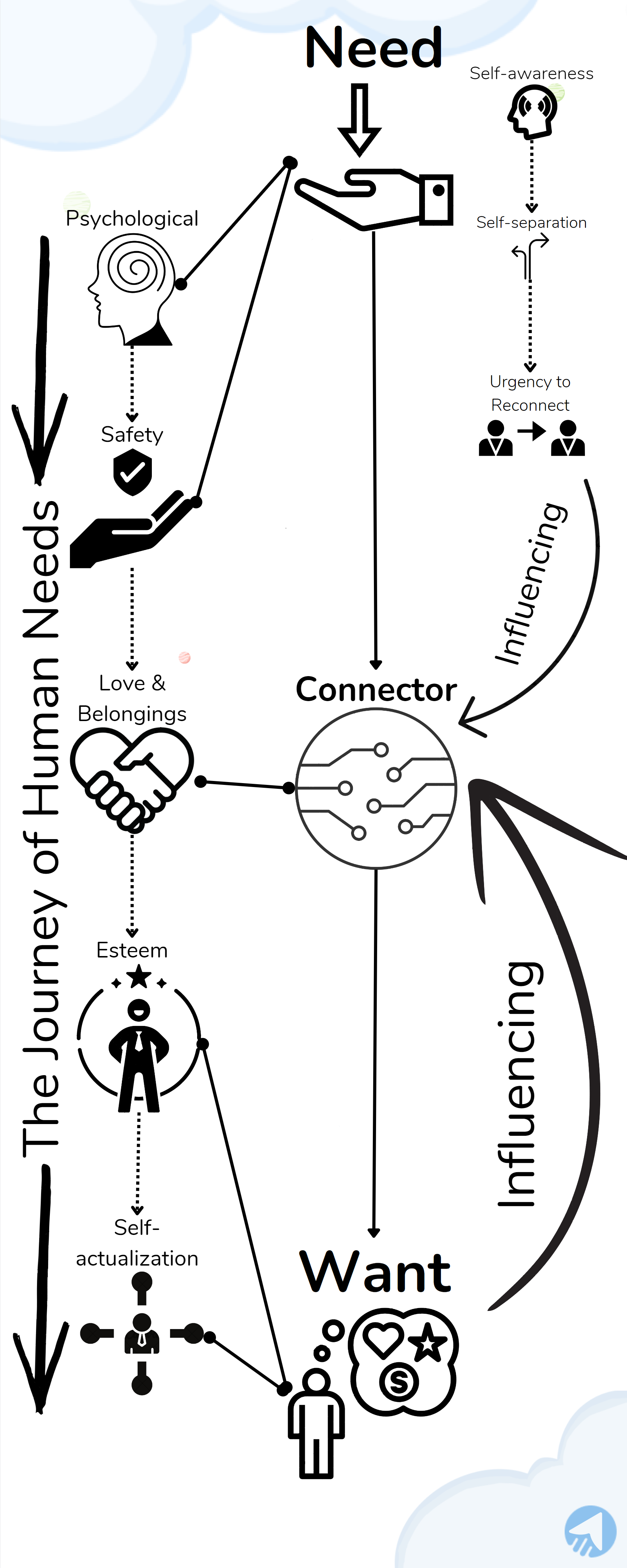
Needs vs. Want
| Differentiators | Need | Want |
| Immediate use | If you have two bottles of water, one might be utilized to quench your thirst, but the other is additional. It’s not required for immediate use. But, it will serve you later if you save it. Here, the first bottle of water is immediately needed. | Those items that don’t require right now are not needed. Instead, you can call it “want.” For example, insurance is the future security system, which doesn’t have the “immediate use” feature. You might want your future protection after meeting the primary needs. |
| Lifestyle | If an internet connection at home ensures your “work from home” facility, which provides your livelihood, it is needed. | If you have an internet connection in your home that gives entertainment instead of livelihood, it is not needed but wanted. |
| Additional Costs | Food is the primary requirement for human existence, as said before. But, only the minimal food requirement can be called “need.” | Those who love to have a candlelight dinner in an expensive restaurant with beloved ones just want to have it. Maslow considered this as additional, not needed immediately. |
Trend
There is a general direction in which we develop and move together over a while. A common tendency leads us together in that specific direction or change, and the trend is that common tendency that fuels us to move on and continue the story. The tendency indicates our interest in particular types of behavior.
The question is, what arouses our interest? In 1967, Francis J. Aguilar published his critical book Scanning the Business Environment, showing that six external elements influence the trend. Analyzing these elements can lead you to understand the trends of your targeted audiences and your future business environment. Francis named that analysis PESTLE.
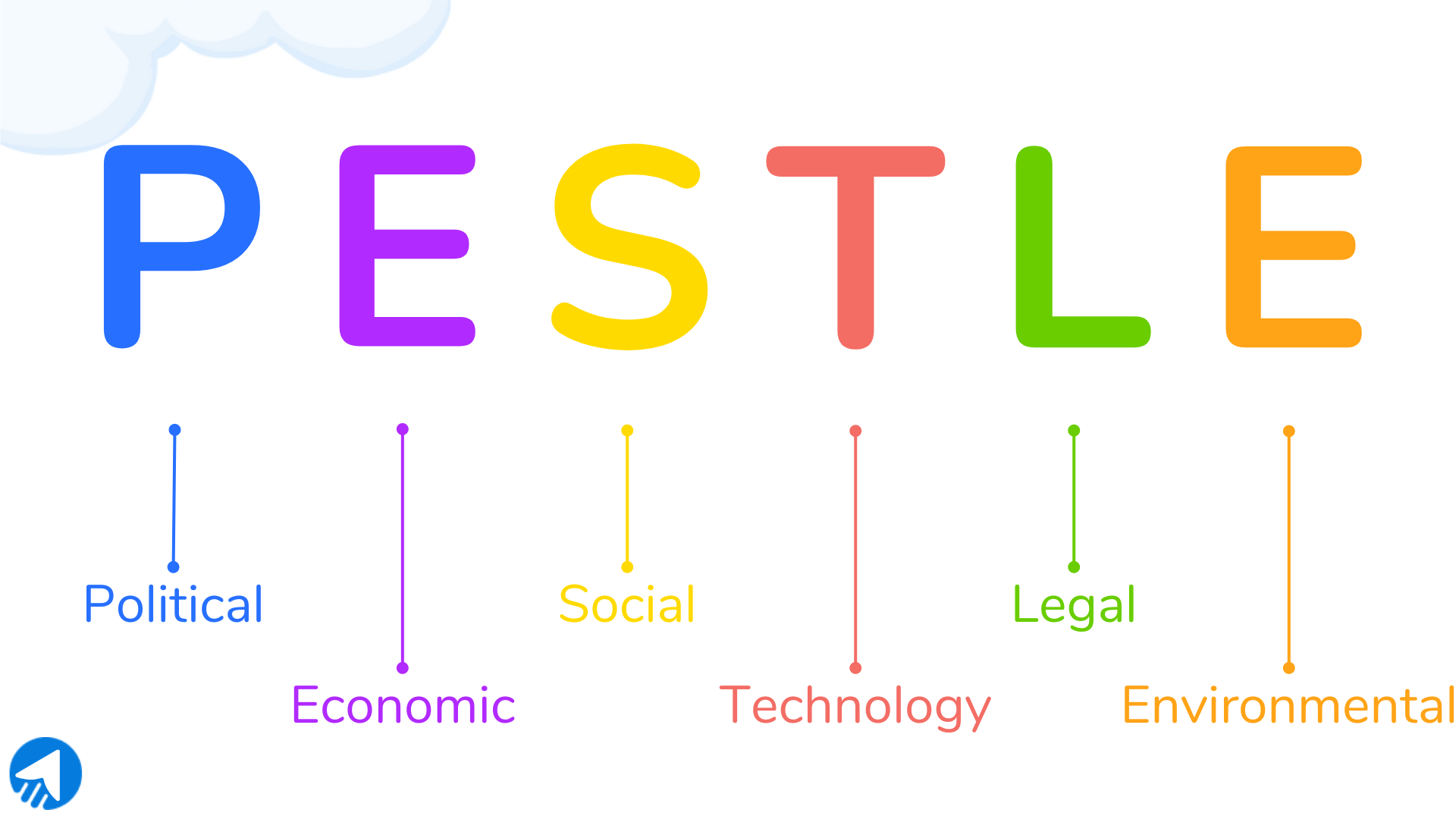
Political
A citizen’s interest depends on governmental policies, political stabilities, taxes, industry regulations, and other political elements like global trade agreements and restrictions. The government’s decisions are considered political factors which directly affect our trends.
Economic
The economic situation of a state affects the trend of that region. For example, when inflation takes place, the value of currency decreases rapidly. At that time, those who tend to buy a car before might think to prioritize their basic needs first, revising the economic situation.
Social
The social element includes the demography of a state and its culture. The significant demographic data are age distributions, gender percentages, education levels, population growth rate, etc.
On the contrary, the cultural elements are the population’s beliefs, values, and attributes.
Technology
Technology is the key to changing the current trend as it takes us to advance. Nobody wants to fall behind when a new shift arrives. Instead, people tend to ensure that they are up to date with the latest discoveries. Technology makes us surprised with unpredictable changes with immense potential.
Legal
Laws, regulations, and legislations of a state determine the tendency and attributes of its citizens. The legal factors allow the citizens to take particular actions (under the law) and help them do it. For example, many countries motivate their starters with money and support to take the initiative. In other words, the legal factors influence the citizens to be trendy (and up to date).
Environmental
The human attributes vary from geographical locations, climates, and resource availabilities. Countries with enough natural resources, like Saudi Arabia and Russia, have other trends than those with fewer. Again, those who live in below-freezing temperatures have other attributes and cultures compared to the middle-east.
How Customers Lie to Themselves Based on Trends
Human minds aim to remain in the status quo, the current state of things, which they obtain from the worldview. A change grabs an audience’s attention and makes them find the reason behind the difference at first. Reasoning drives them to predict the sequence of that change. If the prediction comes true, the audience can settle back to the status quo, skipping participation in the story. The question is, what influences the audience to predict something? The answer is the trend.
When it becomes the case for your consumers, they decide long before they purchase.
Simply put, buying an updated iPhone is a trend in developed countries and developing countries. It makes the consumers feel modern. They think it is because they believe it is a high time to be advantageous with the latest technologies.
Similarly, using organic products makes people feel good (and safe) nowadays, not because it saves lives but because it is the trend.
8 Powers of Mind to Route the Story
We have storified minds to shape our thoughts into the story, which took place after evolving the human brain and the mind in the later stages. According to Robert Mckee, the mind grew eight powerful faculties to storify the thoughts. In other words, eight elements in our mind empower the story.
1Self-awareness
Self-awareness came with the primary human thought, as noted earlier. This stage of mind first distinguishes the mind’s core self from the public self, and then the core self observes the public self as if it (the public self) was separated from the core as always. After considering the “core self,” the mind starts thinking that this part remains unchanged through time, unlike the public self. Later, the core self-realized that it couldn’t be existential without the outer self (public self). In a word, self-awareness separated human minds from other existences and then made them rely on them (other existences).
2Other-awareness
Self-awareness enables us to have different points of view. Thus, when we attempt to look from another’s perspective, we feel the same as if it is the case of our own. Other awareness enables your mind to think that whatever happens inside yours also happens inside the mind of others, resulting in arousing empathy. As mentioned before, empathy is the key to connecting with others through storytelling.
3Memory
Awareness enables us to take place in time with our experiences (our perception of changes). But the experiences need a storage machine or memory so that the mind can compare those (past experiences) at a time to predict the future. Memory sews seeds of understanding by recording a pattern of experiences and then stacking the common ways that can tell us “how things work.”
4Intelligence
This stage of mind aims to find the reasoning behind the experiences through logic to reach a meaningful conclusion. It also spots all the fallacies and refutes them to keep the decision truthful.
5Imagination
Without imagination, the bundle of experience might seem narrative to others. But imagination can bring life to the narrative, renewing itself as memorable and flexible for the audiences. Imagination aims to reshape experiences (as narratives) into more flexible and communicable ones.
6Insight
The insight seeks to see the inner casualties of the change. The data and descriptions only provide us with the outer impacts of the change, but the insight tends to unwrap the cause and effect behind it. The worldview is the thing that fuels our insight, and the storyteller, as we see, uses their keen perspective empowered by worldview to show us a world we think we understand. But, then reality surprises us with more questions (based on our wrong prediction) like how and why the change has occurred.
7Correlation
The correlating mind perceives two descriptions (or perspectives) of the change and then aims to seek a third point of view that has never been perceived before. In a word, by analyzing two points of view, the correlating mind finds the one that connects both perceived perspectives uniquely.
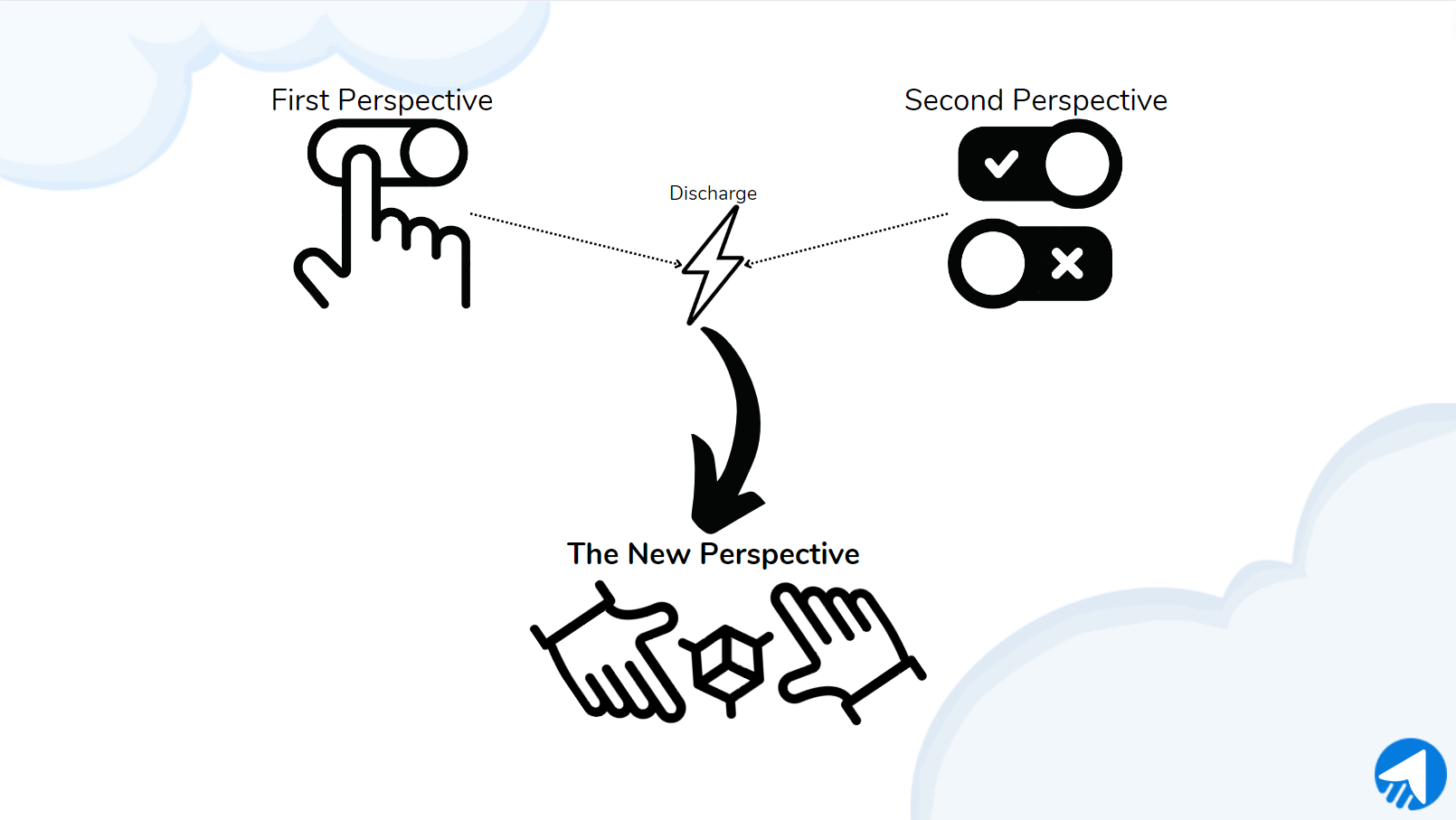
8Self-expression
The correlated point of view is the common element in serving the audience. The above seven powers of the mind can be elaborated through “self-expression.” In other words, self-expression is the stage of the mind that aims to express thoughts with proper demonstration and evaluation.
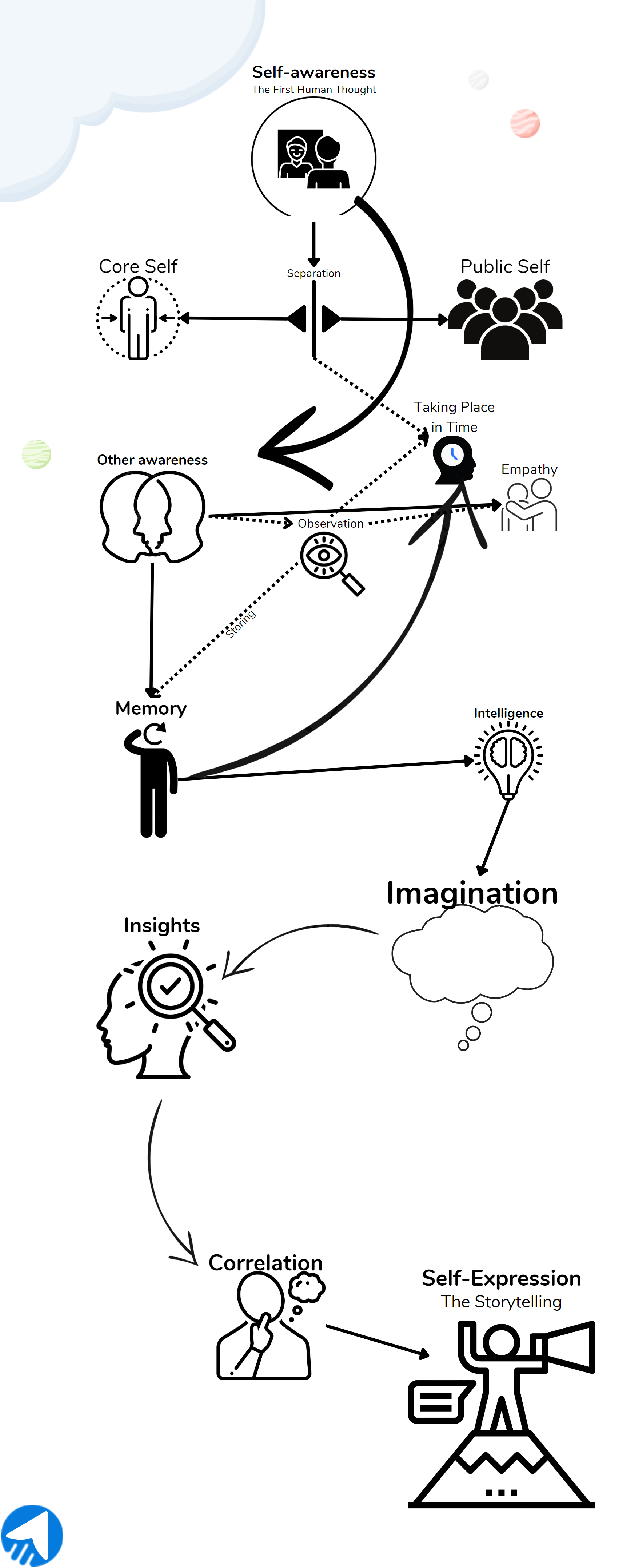
8 Stages to Brand Storytelling
Let’s watch the advertisement below, through which sales of Dove jumped from $2.5 to $4 billion.
The question is, what influence drove the consumers to buy Dove’s product?
Empathy, in a word, is the answer. Throughout this story, Dove differentiates between how we think and what others think we are. One of the story’s protagonists is an artist who, in the end, asks those who describe them to help him (the protagonist) with the artwork – Do you think you are more beautiful than you say? This question is the empathy that connects the audience to the story and makes it successful. Successful Brand storytelling has eight stages when to create.
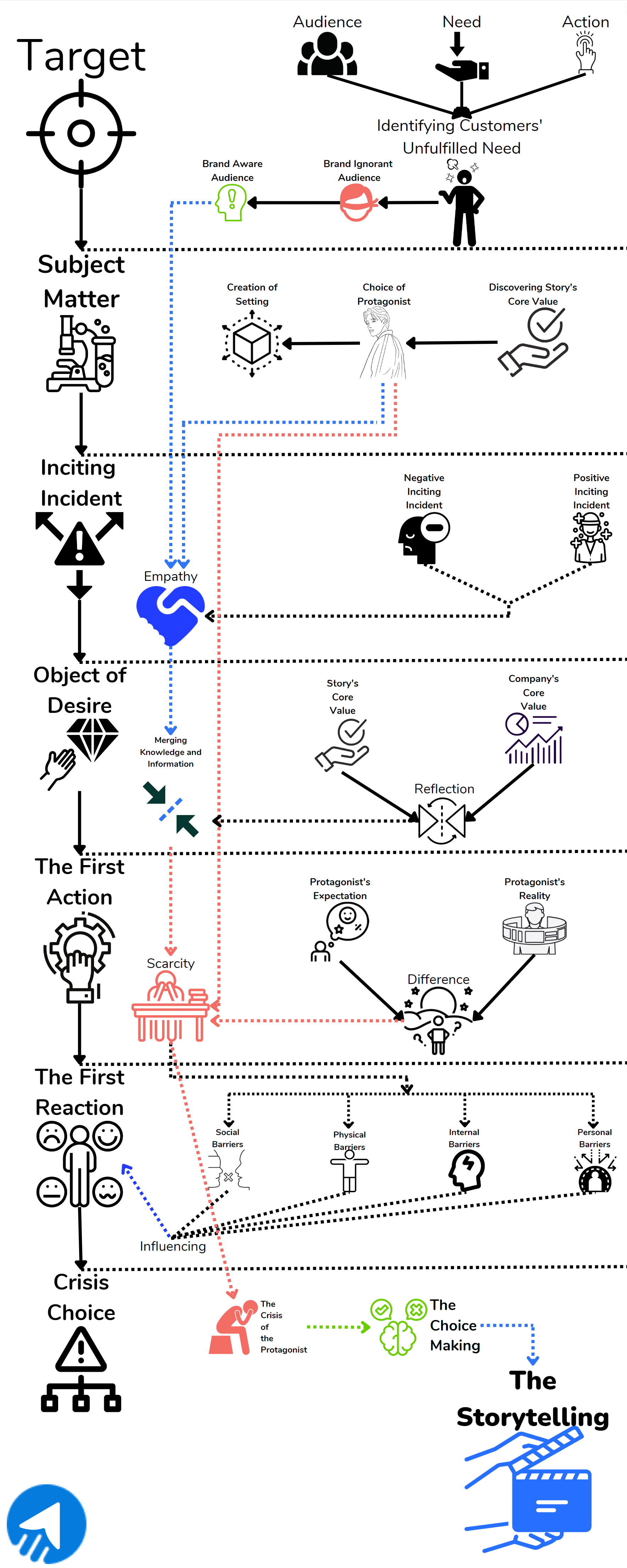
1Target
In the primary stage of Creating the brand story; you need to identify the target. As a marketer, you need to know exactly where you’re aiming, what needs you seek to fulfill, and what action you want your target to take. In other words, three targets need to be recognized before creating the purpose-told story (brand story).
- The Targeted Audience: The story needs a targeted audience. The audiences won’t pick any specific story, as they have different interests, ages, educational status, incomes, and worldviews. As mentioned earlier, attempting to change their worldview is not wise. Thus, you need to specify your targeted audiences based on their attributes to ensure that empathy will perform flawlessly. Thorough research can bring you a proper understanding of the targeted audiences.
- The Targeted Need: Research-driven data will show the audience’s public self, allowing you to know what they have on their shelves, not what’s in their hearts. Dove Real Beauty Sketches melt the audiences’ hearts, knowing what the targeted audience mainly desires.
- The Targeted Action: You also need to specify the action you want your targeted audiences (with the targeted need) will take after storifying. For example, Dove aimed to create “empathy” that triggered its audiences to purchase Dove’s products. The target was specified, which resulted in a massive increase in sales throughout the world.
2Subject Matter
You need the plot to imagine after identifying the target of your story. Preparing the subject matter will show you the way to the plot in three significant steps.
- Discovering the Story’s Core Value: Specifying the untold desire of the targeted audience in the primary stage will take you to discover the core value of your story. The story’s core value aims to dramatically cure its audience’s pain, just as the protagonist from Dove Real Beauty Sketches attempts to do by arousing the question (or empathy).
- Choice of Protagonist: The second step of preparing the subject matter attempts to find out what kind of protagonist the story demands. Robert Mckee, in his book Storynomics, showed that there are three types of protagonists.
- Resource Centric: Resource-centric protagonist focuses on the resources or the raw materials of the product (to serve). Those who want to create a story for the ready-made food business might want to focus on raw materials that are fresh and organic to magnetize maximum consumers.
- Product Centric: The product-centric protagonist aims to be the metaphor of the product. Apple’s Get a Mac campaign is the perfect example of the product-centric protagonist.
- Service-Centric: Service-centric protagonist is usually served by the targeted service (to sell) and comes out dominant, focusing on how good and effective the service is.
You can’t focus on every type of protagonist in one story, as it will confuse your audience. Rather, you must pick the best type to arouse maximum empathy.
- Creation of Setting: Your plot needs time and place in audiences’ minds, as we can’t think of any thinking without time and space. Apple’s Macintosh commercial in 1984 is the perfect example for the creation of the setting. Because Apple picked a time that matches the concept of the book 1984 by George Orwell, which helped the audience with a proper understanding of the context and communication.
3Inciting Incident
In this stage, you need to discover the incident that will imbalance your protagonist’s life positively or negatively. In a word, inciting incidents attempt to figure out the change that grabs the audience’s attention (or the first impression) and arouses curiosity with a question that only the climax can answer – “How will this incident turn out in the end?” Inciting incidents tend to make your consumers inclined to the climax and listen to your story till the end.
Let’s watch the story “Spain’s State Lottery: December 21st.”
Spain’s State Lottery is the second oldest in the world, which has been operated on 22nd December every year since 1812. It has become a national phenomenon over time, as 75 percent of the Spanish participate. The above story reflected that phenomenon, containing a great example of the inciting incident.
In this story, one of the protagonists is a grandmother who misunderstands the referral draw. She burst with joy, watching that her number had been matched. Sadly, it is the recap of the previous year that she misses watching. She also misses that the day is the 21st of December, not the 22nd. The storyteller picked that misunderstanding as the inciting incident, which hooks the audience with empathy and makes them watch till the climax with a question in mind – “How will this incident turn out in the end?”
4The Object of Desire
The inciting incident arouses empathy and curiosity in the audience’s minds. On the other hand, the object of desire nurtures these feelings till the climax, focusing on restoring the imbalance in the protagonist’s life. Empathy makes the audiences own the story as if it is their own, feeling the thirst to rebalance. So, you need to find out the desire of your audience that you will want to put inside your protagonist to produce the best mirror experience.
In the story December 21st, another protagonist is the father (the grandmother’s son), who finds his mother bursting into joy after matching the number. Neither he nor anybody wants to stop her from enjoying her moments. Thus, the object of desire of the story is to prevent the grandmother from any kind of disappointment and embarrassment. In Dove Real Beauty Sketches, the story maker decided to put a curtain between the artist and the object so that the artist couldn’t see the object. The curtain is the inciting incident that arouses interest in the audience’s minds. Later, the object of desire becomes the differentiator between the description of self and others.
5The First Action
The object of desire causes expectation in both protagonist’s and the audience’s minds, merging their knowledge, information, and worldviews, which will aim to trigger the protagonist to take the first action. But, after attempting to take the first action, the protagonist faces a reality that doesn’t synchronize with the expectation, which results in scarcity that both audiences and the characters of the story feel.
In the story December 21st, the grandmother’s son attempts to take the first action by telling her the truth, carrying her jacket thinking about her comfort after she knows it. But every action reacts, as does this story’s first action.
6The First Reaction
Attempting to take the first action usually ends with the first reaction. The reaction might come from societal worldviews, previous personal worldviews, as well as physical. As said before, we face duality inside us with conceiving stories, especially after predicting based on the perceived change or the inciting incident. One part of us wants our prediction to come true so we can be inclined to our previous point of view. We love to see ourselves synchronizing with our beliefs and hate to see ourselves wrong.
The problem is that this part has no participation in progressing the story. The story continues with the help of another part of our inner self, which becomes curious after knowing that the prediction is completely wrong. Later, it raises curiosity (as well as empathy) which is the key to the story’s progress. In a word, the second part (progressive part) of our mind aims to face the first reaction, such as social or inner barriers, superstitions, etc.
In the story of Dove Real Beauty Sketches, the objects (and audiences in the mirror experience) are proven wrong with their present worldview. Their present worldview about themselves fails to think of how beautiful they are that the strangers point out with the help of the artist. Robert Mckee used the term “negaphobia” in his book Storynomics, which indicates the fear of all things might be negative. Negaphobia drives us to feel down about ourselves; Dove pointed it out to connect with each audience with that unusual feeling inside them.
What a great connector (the humanitarian bridge) Dove found!
7Crisis Choice
The object of desire retains the question, “How will this incident turn out in the end?” from stage three to stage seven. The crisis choice is the stage where the protagonist of the brand story chooses to answer the question of the audience. In other words, the protagonist chooses from their side, as the audience eagerly waits for the answer to the problem they have been sharing empathically from the beginning of the story. In fiction told story, the protagonist has several options to choose from, but in a purpose-told tale, they don’t. A brand story’s protagonist chooses the solution the brand aims to sell only.
Though the product-centric protagonists from the “Get a Mac” campaign leave the crisis choice to the audience, their comparison of a Mac and a Microsoft-operated PC triggers them to choose a Mac instead of Microsoft. But in “Dove Real Beauty Sketches,” the artist asks one of the objects a question – “Do you think you are more beautiful than you say?” The answer proves the objects (protagonists) and also the audiences wrong in a positive way!
The answer is “Yeah!”
8The Brand Storytelling
After engaging all the elements, stage eight aims to tell the story in a dramatic way to maximize the mirror experience. As mentioned earlier, the brand story starts with the marketer’s attempts (the storyteller), but it ends in reality when the audiences take steps influenced by the story. The audiences are flooded with a charge of understanding while storified, a new vision that emotionally (and positively) influences the audience’s mind. Neuroscientists found that this phenomenon lasts for six to eight seconds, which the Author of the book Storynomics named “The Open Mind Moments.”
All the strategy of Brand Storytelling aims to make the Open-mind moment successful, as this moment creates a powerful impression with the help of a force of the story. The story is undoubtedly the most powerful thing.
The Importance of Brand Storytelling
Nothing can defeat a story, as it is the key to our understanding. The story enables us to laugh at something we never found funny before or cry at something we never thought tragic. In a word, a story helps to discover new experiences. We participate in time with the experiences stored in our memory, and the story’s plot is the element that helps us memorize things. The more your brand story matches your audience’s worldview, the more relevant it will be compared to your competitors. Nothing can engage your customers with your brand more than your brand storytelling.
Brand storytelling doesn’t aim to ask consumers to purchase directly; instead, it influences and encourages its audiences with their real-life actions, making communication more effective. It is crucial in every medium of your business communication, including email, social media, TV advertisement, etc. Among all of the mediums, email marketing is the most vital as, according to Radicati, the number of email users will increase to 4.4 billion by the end of 2024. By 2025, the average number of emails sent will be 378 billion per day.
But, there is a problem. Each user has almost half of all received emails as unread because many marketers fail to connect with the worldviews of the audiences while sending their marketing emails, which lacks understanding. 90% of Americans subscribe to newsletter updates, and among them, 80% want the brands to use their brand storytelling in the email content. Others remain unengaged with the brand, reducing the ROI of the business.
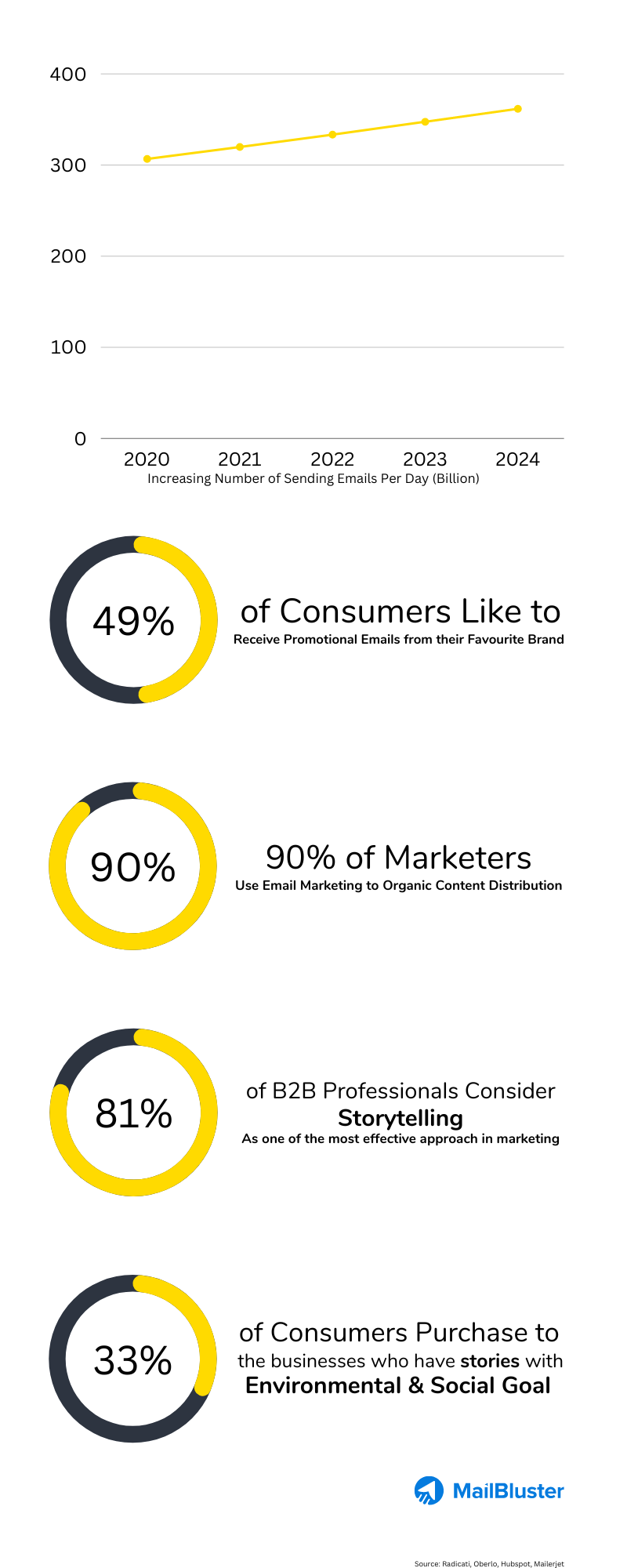
Brand storytelling can help you engage your customers, unlike any other, enabling you to get the best return on investments. On the other hand, MailBluster, with its best pricing, can help you increase the ROI on another level.


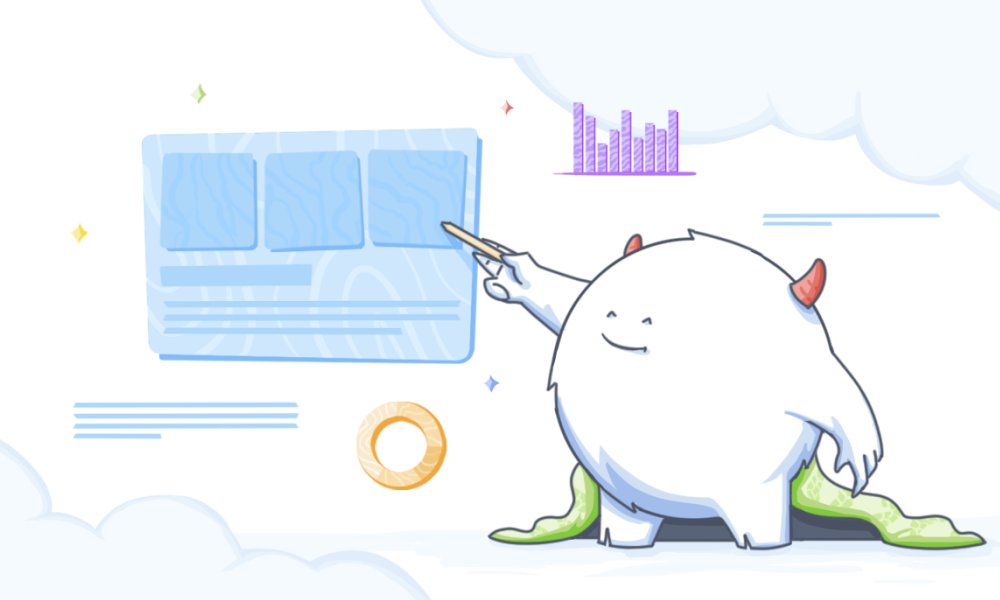
 Contents
Contents